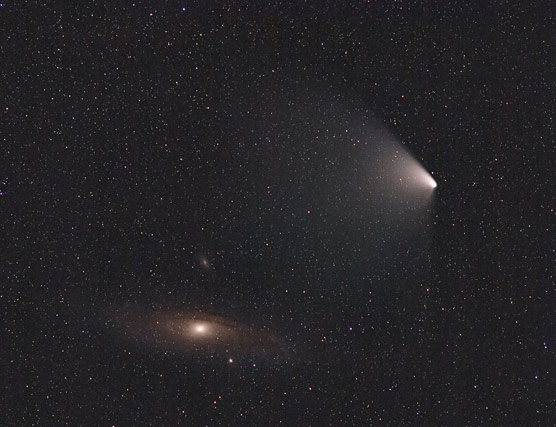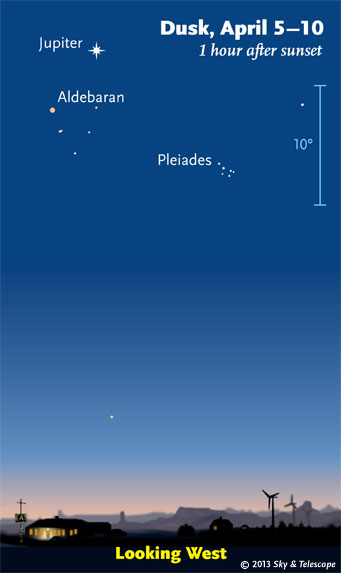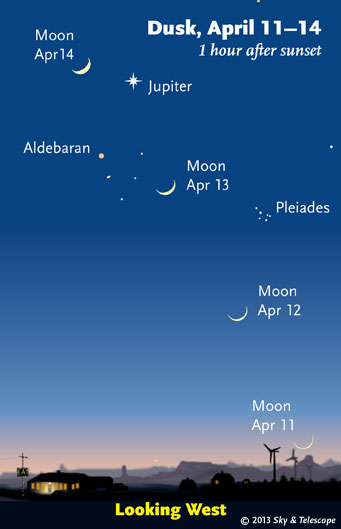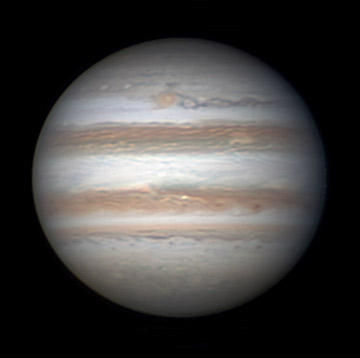
Deep sky and shallow sky. Just before dawn on April 4th, S&T's Sean Walker took this image of Comet PanSTARRS passing 2.4° from M31, the Andromeda Galaxy. The galaxy is 2.5 million light-years away; the comet was 11 light-minutes away. Shooting from latitude 43° north in New Hampshire, Walker stacked 12 minutes of exposures (11 x 70 seconds) taken with a 180-mm lens at f/4 on a Canon 1000D camera at ISO 800. Click for larger view. S&T: Sean Walker |
Comet PanSTARRS is entering dark skies for observers in the latitudes of the northern U.S., Canada, and much of Europe, though it's fading as it moves away from both Sun and Earth.
In the first week of April the comet is still near the Andromeda Galaxy, M31, giving astrophotographers at northerly locations a unique opportunity. The image above was taken on the morning of April 4th, when the comet was closest to the galaxy. By the evening of April 9th their separation will be back up to 6°.
The comet is now higher before dawn (low in the northeast) than it is after dusk (low in the northwest). Either way, the farther north of 40° latitude you are the better. See article.

Jupiter is on its way to passing directly above Aldebaran and the Hyades. (The blue 10° scale is about the width of your fist at arm's length.)
Friday, April 5
Saturday, April 6
Sunday, April 7
Monday, April 8
Tuesday, April 9
Wednesday, April 10

Near the middle of April, the evening crescent Moon waxes past the descending Jupiter family. (These scenes are drawn for the middle of North America. European observers: move each Moon symbol a quarter of the way toward the one for the previous date. For clarity, the Moon is shown three times actual size.)
Sky & Telescope diagram
Thursday, April 11
Friday, April 12
Saturday, April 13
Want to become a better amateur astronomer? Learn your way around the constellations. They're the key to locating everything fainter and deeper to hunt with binoculars or a telescope.
For an easy-to-use constellation guide covering the whole evening sky, use the big monthly map in the center of each issue of Sky & Telescope, the essential guide to astronomy. Or download our free Getting Started in Astronomy booklet (which only has bimonthly maps).

The Pocket Sky Atlas plots 30,796 stars to magnitude 7.6 — which may sound like a lot, but that's less than one star in an entire telescopic field of view, on average. By comparison, Sky Atlas 2000.0 plots 81,312 stars to magnitude 8.5, typically one or two stars per telescopic field. Both atlases include many hundreds of deep-sky targets — galaxies, star clusters, and nebulae — to hunt among the stars.
Sky & Telescope
Once you get a telescope, to put it to good use you'll need a detailed, large-scale sky atlas (set of charts). The standards are the little Pocket Sky Atlas, which shows stars to magnitude 7.6; the larger and deeper Sky Atlas 2000.0 (stars to magnitude 8.5); and the even larger Uranometria 2000.0 (stars to magnitude 9.75). And read how to use sky charts with a telescope.
You'll also want a good deep-sky guidebook, such as Sue French's Deep-Sky Wonders collection (which includes its own charts), Sky Atlas 2000.0 Companion by Strong and Sinnott, the bigger Night Sky Observer's Guide by Kepple and Sanner, or the beloved if dated Burnham's Celestial Handbook.
Can a computerized telescope replace charts? Not for beginners, I don't think, and not on mounts and tripods that are less than top-quality mechanically (able to point with better than 0.2° repeatability). As Terence Dickinson and Alan Dyer say in their invaluable Backyard Astronomer's Guide, "A full appreciation of the universe cannot come without developing the skills to find things in the sky and understanding how the sky works. This knowledge comes only by spending time under the stars with star maps in hand."
This Week's Planet Roundup
Mercury (magnitude 0) is having a poor apparition very low in the dawn. Look for it just above the east horizon about 30 minutes before sunrise.
Venus and Mars remain hidden in the glare of the Sun.

Jupiter's orange Oval BA was near the central meridian when Christopher Go took this image on April 4th. (The System II longitude on the central meridian was 115°.) Three dark-rimmed white ovals follow behind it. Far below it here in the North Equatorial Belt, note the small, bright white weather outbreak. South is up.
Jupiter (magnitude –2.1, in Taurus) comes into view high in the west after sunset and descends through the evening. Lower left of Jupiter is fainter orange Aldebaran. Farther to Jupiter's lower right are the Pleiades. In a telescope, Jupiter has shrunk to 35 arcseconds wide.
Saturn (magnitude +0.2, in Libra) now rises in the east-southeast around the end of twilight. Look for it well to the lower left of Spica, and farther to the lower right of brighter Arcturus. Saturn shines highest in the south around 2 a.m. daylight saving time — more or less between Spica to its right, and Delta Scorpii (and then Antares) farther to its lower left. Saturn reaches opposition on the night of April 27th.
Uranus and Neptune are out of sight in the dawn.
All descriptions that relate to your horizon — including the words up, down, right, and left — are written for the world's mid-northern latitudes. Descriptions that also depend on longitude (mainly Moon positions) are for North America. Eastern Daylight Time (EDT) equals Universal Time (also known as UT, UTC, or GMT) minus 4 hours.
Like This Week's Sky at a Glance? Watch our SkyWeek TV short. It's also playing on PBS!
To be sure to get the current Sky at a Glance, bookmark this URL:
http://SkyandTelescope.com/observing/ataglance?1=1
If pictures fail to load, refresh the page. If they still fail to load, change the 1 at the end of the URL to any other character and try again.
 0
0
Comments
You must be logged in to post a comment.